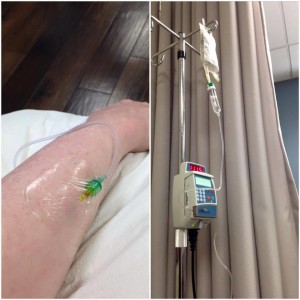The First Treatment
After talking it over with my neurologist’s nurse, I chose a treatment: Tysabri. It is a monthly infusion that effectively stops the progression of relapsing/remitting multiple sclerosis (RRMS) in many with the disease.
Being on Tysabri does carry risk, as many medications do. It increases the risk of getting PML, a rare brain infection) that usually leads to death or severe disability. Risk factors for the development of PML include duration of therapy, prior use of immunosuppressants and presence of anti-JCV antibodies. However, because I had never been on this therapy, I have never used immunosuppressants (or had a chemotherapy-induced immunosuppression), and I tested negative for the JC virus.
I was a perfect candidate to start Tysabri. Plus, I’m getting regular blood tests to make sure I don’t have JCV, so I am being closely monitored.
My first appointment required the presence of a physician, so I am grateful the doc agreed to come in on a Sunday morning. It’s pretty cool my infusion center (which is down the street from my house!) is open on weekends so I don’t need to interrupt my work week for treatment.
I was the first patient to arrive at the center, which is staffed by two nurses on Sundays. I was escorted into a large room that had about 10 chairs, but no one else was there yet. I had to fill out a lot of paperwork, as is usually the case, and then I had to meet with the doctor fora few minutes. Then, I hoped we would get started. However, we were about an hour late. Here’s why…
They couldn’t fine a vein. I’ve always known that I have tiny veins. Most people need to use a butterfly needle to stick me, but the use of a butterfly needle with infusions will make them take twice as long; at least, I think it’s twice as long. I’ll need to find out with my next one.
 After multiple sticks (and instant bruising) with a regular needle, they finally got the line in and started the infusion. It takes one hour, plus an hour or observation when the IV drip is done.
After multiple sticks (and instant bruising) with a regular needle, they finally got the line in and started the infusion. It takes one hour, plus an hour or observation when the IV drip is done.
As I sat there, every chair was filled with people getting infusions. From teenager to senior, there were all walks of life in those chairs. And many of them already had lines in them. I can’t imagine having to live with a line in your arm, or a port somewhere in your body. I admire the strength of those people.
People came and went, but I remained for my lengthy visit. The chairs were constantly filled, but most had a short infusion time. I played on my phone, watched a news broadcast on TV…I was even offered snacks and told I could bring anything I wanted to snack on in the future.
Two older women next to me must have the same infusion times. They carried on like friends do, discussing everything from their families to their last infusions to life in their respective towns to what they were going to eat later for lunch. One mentioned how she wanted soup and the other said, “You love your soup!” This exchange gave me a craving for soup. So, I was determined to go to Panera once my observation period was over.
Side effects of this treatment include, but are not limited to, a headache and flu-like symptoms. In that one-hour period, I didn’t feel a thing. We eventually left and headed to Panera.
However, on the drive home I began to have a massive headache. It bugged me the rest of the day, despite taking some Aleve. No matter, I’ll gladly take that over flu-like symptoms. All in all, I’d say it was a successful first infusion. Keep in mind, the infusion helps to stop progression of the disease. It doesn’t “fix” all my symptoms. Those have to get better on their own, and they haven’t just yet.

Leave a Reply